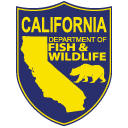Welcome to the Marine Management News Fish Identification Quiz for November 2016! Here’s your chance to show off your fish identification knowledge and win a “Release At Depth” rockfish barotrauma cap. To qualify for the drawing, simply send the correct information to AskMarine@wildlife.ca.gov by December 30, 2016 identifying:
- The species of the fish pictured below (scientific name) and an accepted common name, and
- The daily bag limit, as found in the 2016-2017 Ocean Sport Fishing regulations booklet
Be sure to enter “November MMN Fish Quiz” as the “Subject” of your e-mail. The winner will be selected during a random drawing from all correct answers received by December 30,2016.

See the correct answer to the quiz.
This fish begins its life journey in shallow waters near shore during the spring and early summer months. The young are born live and resemble inch-long miniature versions of their parents. Young fish are often found in shoals in the shallow portions of bays and estuaries, especially around eelgrass beds and the pilings of wharfs and piers. They feed around the clock on tiny animal plankton, whereas older fish feed primarily during daylight hours on plankton, crustaceans, and other invertebrates. They are frequently observed around pier pilings nipping off the appendages of barnacles.
Both young and older fish are tolerant of fresh water, though they generally prefer calm water with a higher salinity content. They have been captured in trawl nets fishing in 350 to 480 feet of water and have been observed by divers at depths as great as 120 feet, but are more numerous in shallow, inshore waters.
Mating usually takes place during the summer months, and the young are born the following spring and summer. During courtship, the male closely follows the female, their movements remarkably well synchronized. The male will leave the female’s side frequently to chase off other fish, many of which are not the least bit attracted to the female. Males are dark gray – almost black – in color (hint, hint) during courtship and breeding, and have a black spot on each side of the snout. Female fish may hold the sperm of several males as the eggs develop within her. The eggs are fertilized in late fall and winter, and the female bears her young four to six months later.
Outside of the mating season, these fish are gray to greenish above with vertical, lemon yellow crossbars in the shape of a “711” and eight horizontal sooty lines along the sides. It is apparently short-lived, as a 6-inch female (large for this species) was aged to just 3 years old. On average, this species lives for just a couple of years in the wild, though some individuals have been reported to live as long as 8 years.
Recreational fishermen catch this fish from shore, docks, piers, rocks, and almost any other fishing area. They are probably the number one fish caught by youngsters along the California coast.
If you think you know this species of fish, enter the prize drawing by sending an e-mail to CDFW at AskMarine@wildlife.ca.gov by December 30, 2016 with the correct scientific name, an accepted common name, and the daily bag limit as found in the 2016-2017 Ocean Sport Fishing regulations booklet. Again, be sure to enter “November MMN Fish Quiz” in the “Subject” portion of your e-mail.

UPDATE — JANUARY 3 Congratulations go out to Sherman Mohnike of Ben Lomond, California for correctly identifying the November 2016 mystery fish as a shiner perch, Cymatogaster aggregata. The daily bag limit for shiner perch is 20 fish per person and in possession, per California Code of Regulations Title 14, Section 28.59(c)(2). You can find this regulation on pg. 45 of the current Ocean Sport Fishing regulations booklet.
Sherman retired 15 years ago, and now spends time fishing on Monterey Bay in his Boston Whaler. “I go out about 25 times a year for salmon, halibut, rockfish, and lingcod, all in Monterey Bay,” he says.
Sherman related that he “swamped the boat last week with three friends aboard. No one was hurt, but the boat was towed some three miles upside down, so it will need some work. I’m putting it back together. I have owned it for 42 years and intend to fish a bit longer.”
After his experience, he says “I highly recommend float coats.” Word to the wise! We’re thankful everyone was OK, Sherman, and wish you all the best in restoring your boat.
We also hope you enjoy wearing your “Release at Depth” rockfish barotrauma cap. “I have been using a barotrauma device for at least 25 years,” he says, “and think their use should be required.” Congratulations again on your commendable rockfish release etiquette and your fish identification skills! We wish you many more enjoyable years of fishing on Monterey Bay.
post by Mary Patyten, CDFW Research Writer

